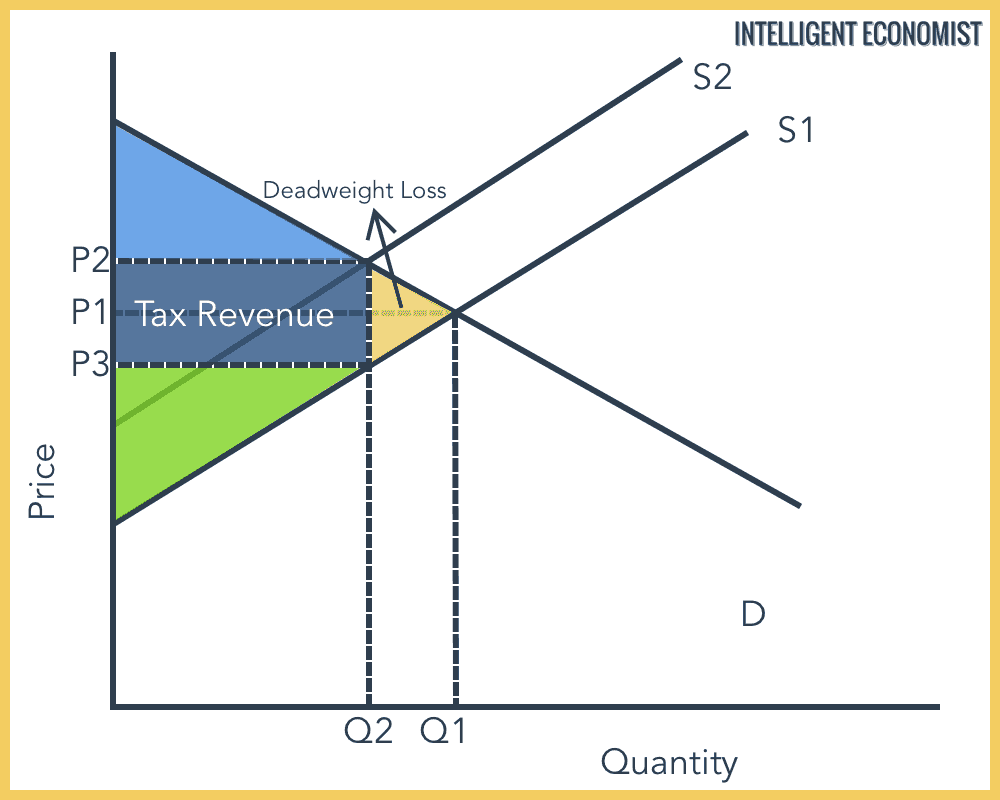A deadweight loss is a cost to society as a whole that is generated by an economically inefficient allocation of resources within the market. Deadweight loss can also be referred to as “excess burden.”
A deadweight loss arises at times when supply and demand–the two most fundamental forces driving the economy–are not balanced. That is, they do not achieve equilibrium. The result is that allocative efficiency is not as high as it could be–it does not reach its maximum level. When levels of trade are lower, resource allocation across an economy is likely to become less efficient.
What is Deadweight Loss?
When supply and demand are not balanced by market forces, consumers may choose not to pay for goods or services because they assess that the price is not worth the utility that they believe these goods/services will offer. With the overall exchange of items for money (trade) being reduced, the efficiency of overall resource allocation drops, and thus the overall societal welfare drops as well.
All deficiencies resulting from sub-optimal resource allocation can be described in terms of deadweight loss. Deadweight losses can be caused by numerous economic factors, including price floors (e.g. rent and price controls), price ceilings (e.g. living and minimum wage laws), taxation, and monopolies.
Why Does a Drop in the Efficiency of Resource Allocation Matter?
A drop in the efficiency of resource allocation matters because it results in a reduction in welfare throughout society. This is highly significant because welfare, in economic terms, refers to a society’s living standards and overall prosperity. These are typically measured via GDP, income, literacy, life span, etc. However, the concept of welfare is such a general term that the definition can often vary depending on the context.
Deadweight Loss and Under-/Overvaluation
Both under- and overvaluation have negative consequences in the form of deadweight loss.
Undervalued Products
Consumers may initially benefit from goods and services being undervalued. However, in the long run, the outcome will be negative: when products are undervalued, firms do not make enough to justify the costs of production, so they will be less motivated to produce these goods and services. Typically, then, firms will raise the price of the product, stop producing and selling the product, or go out of business due to lack of profits.
Overvalued Products
As you might expect, the overvaluation of goods and services has the reverse effect, while still being ultimately negative. When a product is overvalued, the firm that produces it may initially gain higher profits. But in the case of elastic goods, those for which demand changes based on price, consumers are likely to reduce their spending when these goods are overvalued. If the goods are significantly overvalued, consumers may not even be able to purchase any of these goods. This will significantly diminish profits.
With inelastic goods (for which demand is unaffected by the price of the good), overvaluation operates a bit differently. Higher costs will not necessarily prevent consumers from buying as much of the good, but consumers will have more difficulty buying other kinds of goods as a result of overvaluation.
Causes of Deadweight Loss

Many of the causes are unavoidable, entirely necessary components of a functioning society. In all of these cases, external limits on prices of goods or services affect the supply and demand of these goods/services:
1. Taxes
These are charges by the government, in addition to the price of goods or services. One common example would be a sales tax. Taxes increase the price of products, which naturally decreases their demand.
In other words, taxes can contribute to deadweight loss by making consumers less likely to purchase goods and services. Specifically, this problem arises with taxation when taxes make the product cost more than the equilibrium market price. When taxes on a good or service increase, both producers and consumers must shoulder those extra costs.
In practice, this means that consumers pay more, producers earn lower profits, and overall purchases of that good/service decreases. Thus, the outcome is a deadweight loss.
2. Price Ceilings
These price controls are also set by the government and prevent sellers from charging above a certain price for their goods or services. Price ceilings produce deadweight losses as they make production less attractive–so the supply of goods and services can become lower than demand for these products. This means shortages of goods and services will arise.
An example of a price ceiling is rent control. In the case of rent control, the demand may end up being higher than the supply of a building as more people will want to live in a building as compared to the number of people that can actually get an apartment.
3. Price Floors
Price floors are similar to price ceilings but in reverse. They are price controls that prevent businesses or individuals from charging less than a specific amount for goods/services.
One example is minimum wage, which prevents individuals from selling their labor for less than a certain amount per hour. Minimum wage may increase the unemployment rate (a clear deadweight loss) in cases when employers who need to hire employees are unable to pay the minimum wage.
4. Monopolies
The deadweight losses created by monopolies operate similarly to those created by taxation. The distinction between the two lies in the fact that taxes are public and administered by governments, and typically benefit society as a whole, while monopoly profits are private and accrue to the monopolizing firms.
Monopolies set prices for their goods and services that are above marginal cost, effectively a tax, which creates a gap between the firms’ costs and those of the consumers. This leads to distortions in the market, with lower amounts of goods and services being sold.
How to Calculate Deadweight Loss
Deadweight Loss Graph

In the graph above, the yellow triangle is representative of the deadweight loss.
Deadweight Loss Formula

The formula for deadweight loss is as follows:
Deadweight Loss = ½ * (P2 – P1) x (Q1 – Q2)
Here’s what the graph and formula mean:
- Q1 and P1 are the equilibrium price as well as quantity before a tax is imposed.
- A tax shifts the supply curve from S1 to S2. That’s because producers are compelled to want to create less supply as a result of a tax.
- The price for buyers increases from P1 to P2 while the seller’s received price for the good decrease, going from P1 to P3.
- The tax means that producers’ supply decreases, from Q1 to Q2.
Deadweight Loss Example
Let’s say you want to see a concert. The ticket costs $25. You personally assign a value of $35 to the experience of seeing this concert—your favorite musician is performing. You’ll go see this concert because the value is greater than the cost; more precisely, the net value is $10 (calculated as $35-$25).
However, in an alternate scenario, the government might begin taxing concert tickets at 75%. This leaves the new cost of the concert ticket at $43.75. Since you only value the concert at $35, you’ll choose not to attend. The deadweight loss in this scenario ends up being the value of the concert tickets that don’t get purchased due to the extra cost created by the tax.


Hello sir,
Above article elaborates the concept very well and very helpful for all economics students. We expect such articles in future also.
Thank you very much sir..
Thanks for the amazing explanation. Have a quick doubt. Why have we only considered a loss in the Consumer Surplus to compute DWL and not considered a loss in Producer Surplus? I see that in the computation of DWL we have only taken the area of the upper half of the yellow triangle.
Keshav,
I agree that the deadweight loss is both the loss of consumer and producer surplus. That is how it is calculated in my textbook written by Mankiw.
Rick Lotz
The economic notes is very useful to me with so many knowledge that I can gain from this website. I am asking,you can send me more notes on the above email address.
Thank you.
Am really inspired by the way you answer the questions.thank you sir
This was an excellent explanation, thank you.